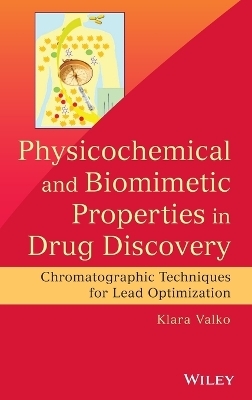
Physicochemical and Biomimetic Properties in Drug Discovery
John Wiley & Sons Inc (Verlag)
978-1-118-15212-6 (ISBN)
Demonstrating how and why to measure physicochemical and biomimetic properties in early stages of drug discovery for lead optimization, Physicochemical and Biomimetic Properties in Drug Discovery encourages readers to discover relationships between various measurements and develop a sense of interdisciplinary thinking that will add to new research in drug discovery. This practical guide includes detailed descriptions of state-of-the-art chromatographic techniques and uses real-life examples and models to help medicinal chemists and scientists and advanced graduate students apply measurement data for optimal drug discovery.
KLARA VALKO is an Investigator in the Analytical Chemistry Department of Molecular Discovery Research at GlaxoSmithKline. Dr. Valko has more than thirty years of experience in HPLC, GC, and LC/MS. She also has more than ten years of experience teaching physicochemical measurements and ADME optimization tools at the UCL School of Pharmacy. Currently, Dr. Valko is an Honorary Professor, leading the Physchem/ADME module for a drug discovery MSc course.
Preface xi
1 The Drug Discovery Process 1
Summary 7
Question for Review 7
References 7
2 Drug-Likeness and Physicochemical Property Space of Known Drugs 9
Summary 12
Questions for Review 13
References 13
3 Basic Pharmacokinetic Properties 15
Absorption 17
Plasma Protein Binding 20
Distribution 22
Volume of Distribution 23
Unbound Volume of Distribution 29
Half-Life 30
Metabolism and Clearance 30
Free Drug Hypothesis 31
Summary 31
Questions for Review 32
References 33
4 Principles and Methods of Chromatography for the Application of Property Measurements 34
Theoretical Background of Chromatography 35
Retention Factor and Its Relation to the Distribution Constant Between the Mobile and the Stationary
Phases 37
Measure of Separation Efficiency 40
Resolution and Separation Time 42
Gradient Elution 44
Applicability of Chromatography for Measurements of Molecular Properties 47
Summary 49
Questions for Review 50
References 50
5 Molecular Physicochemical Properties that Influence Absorption and Distribution—Lipophilicity 52
Partition Coefficient 52
Lipophilicity Measurements by Reversed Phase Chromatography with Isocratic Elution 58
Lipophilicity Measurements by Reversed Phase Chromatography with Gradient Elution 68
Lipophilicity of Charged Molecules—pH Dependence of Lipophilicity 72
Biomimetic Lipophilicity Measurements by Chromatography 78
Comparing Various Lipophilicity Measures by the Solvation Equation Model 90
Summary 102
Questions for Review 105
References 105
6 Molecular Physicochemical Properties that Influence Absorption and Distribution—Solubility 112
Definition of Solubility 112
Molecular Interactions with Water 116
Various Solubility Measurements that can be Applied During the Drug Discovery Process 119
Conditions that Affect Solubility 121
Solubility–pH Profile 132
Solubility and Dissolution in Biorelevant Media 134
Composition of Fasted State Simulated Intestinal Fluid (FaSSIF) 136
Preparation of FaSSIF Solution 136
Composition of Fed State Simulated Intestinal Fluid (FeSSIF) 136
Preparation of FeSSIF solution 136
Summary 143
Questions for Review 146
References 146
7 Molecular Physicochemical Properties that Influence Absorption and Distribution—Permeability 150
Biological Membranes 150
Artificial Membranes 153
Physicochemical Principles of Permeability 155
Experimental Methods to Measure Artificial Membrane Permeability 159
Relationships Between Permeability, Lipophilicity, and Solubility 166
Chromatography as a Potential Tool for Measuring the Rate of Permeation 171
Summary 175
Questions for Review 178
References 178
8 Molecular Physicochemical Properties that Influence Absorption and Distribution—Acid Dissociation Constant—pKa 182
Definition of pKa 182
Methods for Determining pKa 188
Spectrophotometric Determination of pKa 192
Determination of pKa by Capillary Electrophoresis 195
Chromatographic Approaches for the Determination of pKa 197
Summary 207
Questions for Review 209
References 209
9 Models with Measured Physicochemical and Biomimetic Chromatographic Descriptors—Absorption 213
Lipinski Rule of Five 214
Absorption Models with Lipophilicity and Size 217
Biopharmaceutics Classification System (BCS) 221
Absorption Potential—Maximum Absorbable Dose 227
Abraham Solvation Equations for Modeling Absorption 232
Effect of Active Transport and Metabolizing Enzymes on Oral Absorption and Bioavailability 235
Summary 236
Questions for Review 238
References 238
10 Models with Measured Physicochemical and Biomimetic Chromatographic Descriptors—Distribution 242
Models for Volume of Distribution 249
Plasma Protein Binding 276
Blood/Brain Distributions 288
Tissue Distribution 294
Summary 296
Questions for Review 298
References 298
11 Models with Measured Physicochemical and Biomimetic Chromatographic Descriptors—Drug Efficiency 303
Drug Efficiency 303
Summary 327
Questions for Review 327
References 328
12 Applications and Examples in Drug Discovery 330
Structure–Lipophilicity Relationships 330
Structure–Solubility Relationships 346
Structure–Permeability Relationships 354
Structure–Charge State Relationships 362
Structure–Protein Binding Relationships 366
Structure–Phospholipid Binding Relationships 371
Summary 376
Questions for Review 379
References 379
Appendix A Answers to the Questions for Review 387
Appendix B List of Abbreviations and Symbols 427
Index 433
| Erscheint lt. Verlag | 18.2.2014 |
|---|---|
| Verlagsort | New York |
| Sprache | englisch |
| Maße | 165 x 241 mm |
| Gewicht | 785 g |
| Themenwelt | Naturwissenschaften ► Chemie |
| Technik | |
| ISBN-10 | 1-118-15212-3 / 1118152123 |
| ISBN-13 | 978-1-118-15212-6 / 9781118152126 |
| Zustand | Neuware |
| Haben Sie eine Frage zum Produkt? |
aus dem Bereich


